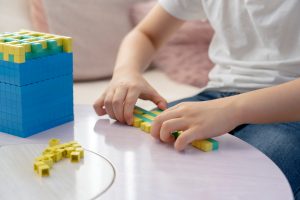There is a common stereotype that boys are better than girls at math. But is it true? You may be surprised to learn that girls tend to get better grades than boys do in math class and perform as well as, or better than, boys on tests that are aligned with school curriculums, such as statewide standards-based math tests. [1, 2, 3, 4]
On the other hand, boys perform better on high-stakes standardized tests, such as the SAT, ACT, and GRE, which measure math skills that are not as closely tied to what is taught in the classroom. [5, 6, 7, 8] Importantly, gender differences in performance on high-stakes math tests are small, and some studies show evidence that they have become smaller over historical time. [8, 9, 10]
In fact, many studies find no gender differences on a variety of simple math tasks, like addition and subtraction or number comparison. [11, 12, 13]
There are many reasons why boys tend to perform better on standardized math tests while girls tend to perform better in school. We consider why these differences may exist in the first place and how we can support the math learning of all children—both girls and boys.
Spatial Skills
Boys tend to do better on some types of spatial tasks, such as mentally rotating an object, which has been shown to relate to math performance, perhaps because strong spatial skills help children visualize the problem and reach the correct solution. [14, 15] Moreover, there is some evidence that spatial skills may be important when it comes to solving novel math problems, just the kinds of problems that are likely to be on high-stakes standardized tests. [16]
Spatial visualization skills are malleable and have been shown to relate to spatial play with blocks and certain kinds of video games, both of which boys engage in more frequently than girls do. [17, 18, 19] Encouraging all children to engage in play that promotes spatial thinking could help girls and boys to develop better math skills.
Confidence and Expectations
Another reason that boys may outperform girls on high-stakes math tests is that girls may be less confident about their math skills and more nervous about math than boys are. [20, 21] By elementary school, most girls know about the stereotype that boys are better at math. This can lead to a phenomenon called stereotype threat, in which fear of confirming the stereotype subconsciously stops girls from performing their best at math. [22]
Some evidence suggests that parents have higher expectations for their sons’ math performance than for their daughters’ and are more likely to encourage their sons to engage in STEM activities. [23, 24] Parents can help children become confident in and form positive attitudes toward math by setting high expectations for their children’s math abilities—regardless of gender—and communicating the value of math and STEM activities to their children.
Self-Discipline
As for why girls might get better grades in math class than boys, some research suggests that’s because girls tend to be more self-disciplined when it comes to their schoolwork. [3] Girls’ diligence may help them to obtain good grades and do well on tests that are aligned with school curriculums. Parents may be able to help children do better in math class by encouraging both boys and girls to keep on top of their schoolwork and maintain high expectations for conscientiousness in the classroom.
No matter the reason for any average gender differences in math, it is important to remember that each child is different and there is a lot of variability in math performance within each gender. Averages do not mean anything about any particular child. Furthermore, it is important to work on cultivating children’s math engagement and interest, because this is what supports math success. Math forms the foundation of STEM disciplines, so it is critically important to invest in the math success of all children, regardless of gender.
[1] Felson, R. B., & Trudeau, L. (1991). Gender differences in mathematics performance. Socialpsychology quarterly, 113-126.
[2] Pomerantz, E. M., Altermatt, E. R., & Saxon, J. L. (2002). Making the grade but feeling distressed: gender differences in academic performance and internal distress. Journal of Educational Psychology, 94(2), 396.
[3] Duckworth, A. L., & Seligman, M. E. (2006). Self-discipline gives girls the edge: Gender in self-discipline, grades, and achievement test scores. Journal of educational psychology, 98(1), 198.
[4] Hyde, J. S., Lindberg, S. M., Linn, M. C., Ellis, A. B., & Williams, C. C. (2008). Gender similarities characterize math performance. Science, 321(5888), 494-495.
[5] American Association of University Women Educational Foundation. (1998). Gender gaps: Where schools still fail our children. Washington, DC.
[6] Ceci, S. J., Williams, W. M., & Barnett, S. M. (2009). Women’s underrepresentation in science: sociocultural and biological considerations. Psychological bulletin, 135(2), 218.
[7] Bleske-Rechek, A., & Browne, K. (2014). Trends in GRE scores and graduate enrollments by gender and ethnicity. Intelligence, 46, 25-34.
[8] Miller, D. I., & Halpern, D. F. (2014). The new science of cognitive gender differences. Trends in cognitive sciences, 18(1), 37-45.
[9] Hyde, J. S., Fennema, E., & Lamon, S. J. (1990). Gender differences in mathematics performance: A meta-analysis. Psychological bulletin, 107(2), 139.
[10] Wai, J., Cacchio, M., Putallaz, M., & Makel, M. C. (2010). Gender differences in the right tail of cognitive abilities: A 30 year examination. Intelligence, 38(4), 412-423.
[11] Spelke, E. S. (2005). Gender differences in intrinsic aptitude for mathematics and science?: a critical review. American Psychologist, 60(9), 950.
[12]Halberda, J., & Feigenson, L. (2008). Developmental change in the acuity of the” Number Sense”: The Approximate Number System in 3-, 4-, 5-, and 6-year-olds and adults. Developmental psychology, 44(5), 1457.
[13] Hutchison, J. E., Lyons, I. M., & Ansari, D. (2019). More Similar Than Different: Gender Differences in Children’s Basic Numerical Skills Are the Exception Not the Rule. Child development, 90(1), 66000-79000.
[14]Casey, M. B., Nuttall, R., Pezaris, E., & Benbow, C. P. (1995). The influence of spatial ability on gender differences in mathematics college entrance test scores across diverse samples. Developmental Psychology, 31(4), 697.
[15] Wai, J., Lubinski, D., & Benbow, C. P. (2009). Spatial ability for STEM domains: Aligning over 50 years of cumulative psychological knowledge solidifies its importance. Journal of Educational Psychology, 101(4), 817.
[16] Mix, K. S. (2019). Why Are Spatial Skill and Mathematics Related?. Child Development Perspectives, 13(2), 121-126.
[17] Baenninger, M., & Newcombe, N. (1989). The role of experience in spatial test performance: A meta-analysis. Gender roles, 20(5-6), 327-344.
[18] Terlecki, M. S., & Newcombe, N. S. (2005). How important is the digital divide? The relation of computer and videogame usage to gender differences in mental rotation ability. Gender roles, 53(5-6), 433-441.
[19] Cherney, I. D., & London, K. (2006). Gender-linked differences in the toys, television shows, computer games, and outdoor activities of 5-to 13-year-old children. Gender roles, 54(9-10), 717.
[20]Ellis, J., Fosdick, B. K., & Rasmussen, C. (2016). Women 1.5 times more likely to leave STEM pipeline after calculus compared to men: Lack of mathematical confidence a potential culprit. PloS one, 11(7), e0157447.
[21] Devine, A., Fawcett, K., Szűcs, D., & Dowker, A. (2012). Gender differences in mathematics anxiety and the relation to mathematics performance while controlling for test anxiety. Behavioral and brain functions, 8(1), 33.
[22] Ambady, N., Shih, M., Kim, A., & Pittinsky, T. L. (2001). Stereotype susceptibility in children: Effects of identity activation on quantitative performance. Psychological science, 12(5), 385-390.
[23] Yee, D. K., & Eccles, J. S. (1988). Parent perceptions and attributions for children’s math achievement. Gender Roles, 19(5-6), 317-333.
[24] Simpkins, S. D., Davis-Kean, P. E., & Eccles, J. S. (2005). Parents’ socializing behavior and children’s participation in math, science, and computer out-of-school activities. Applied Developmental Science, 9(1), 14-30.



